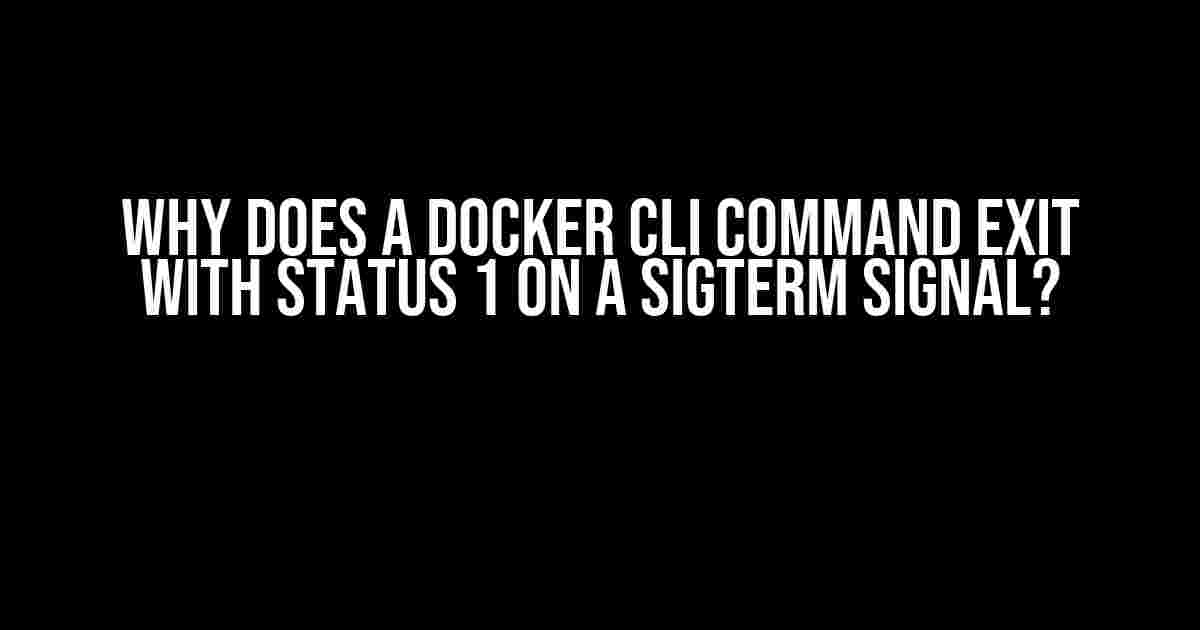Have you ever encountered a situation where your Docker CLI command exits with a status code of 1 when receiving a SIGTERM signal? You’re not alone! In this article, we’ll dive into the world of Docker and signals to understand why this happens and what you can do about it.
What is a SIGTERM Signal?
In Linux, signals are a way to communicate with processes. There are several types of signals, but we’re interested in the SIGTERM signal. When a process receives a SIGTERM signal, it’s like getting a polite request to shut down. The process can choose to ignore the signal, handle it, or exit immediately.
$ docker run -it --name my_container ubuntu sleep 100
In the above example, we start a new Docker container using the Ubuntu image and run the sleep 100 command. Now, let’s send a SIGTERM signal to the container:
$ docker stop my_container
By default, Docker sends a SIGTERM signal to the container when you run the docker stop command. This signal tells the container to shut down gracefully, allowing it to clean up any resources and exit cleanly.
Why Does Docker Exit with Status 1?
So, why does the Docker CLI command exit with a status code of 1 when receiving a SIGTERM signal? The answer lies in how Docker handles signals.
When Docker receives a SIGTERM signal, it propagates the signal to the container process. If the container process ignores the signal or doesn’t handle it correctly, Docker will wait for a short period (around 10 seconds) and then send a SIGKILL signal to force the container to exit. This is where the magic happens.
When Docker sends a SIGKILL signal, it sets the exit status of the container to 1. This is because the container didn’t exit cleanly, and Docker had to intervene to force the exit. Ah-ha! That’s why you see the status code 1.
But Wait, There’s More!
There’s another reason why Docker might exit with a status code of 1. Imagine you’re running a container with a command that ignores SIGTERM signals, like this:
$ docker run -it --name my_container ubuntu /bin/bash -c "trap '' TERM; sleep 100"
In this example, we’re running a Bash shell that ignores SIGTERM signals using the trap command. When we send a SIGTERM signal to the container, the Bash shell will ignore it, and Docker will eventually send a SIGKILL signal to force the exit.
However, there’s a catch. When the Bash shell ignores the SIGTERM signal, it doesn’t exit cleanly, and Docker sets the exit status to 1. This is because the container process didn’t handle the signal correctly, leading to a non-zero exit status.
Solving the Mystery: What Can You Do?
Now that we’ve unraveled the mystery, what can you do to avoid Docker exiting with a status code of 1 when receiving a SIGTERM signal?
Here are a few strategies to help you handle the situation:
-
Use the
--timeoutflag with thedocker stopcommand to specify a longer timeout period. This allows the container to exit more cleanly:$ docker stop --timeout 30 my_container -
Use the
--forceflag with thedocker stopcommand to immediately send a SIGKILL signal to the container. This forces the container to exit, but be careful when using this flag:$ docker stop --force my_container -
Modify your container’s command to handle SIGTERM signals correctly. For example, you can use a signal handler in your application to catch the SIGTERM signal and exit cleanly:
$ docker run -it --name my_container ubuntu /bin/bash -c "trap 'exit 0' TERM; sleep 100"
Conclusion
In this article, we’ve uncovered the mystery of why Docker CLI commands exit with a status code of 1 when receiving a SIGTERM signal. We’ve explored the world of Linux signals, Docker’s signal handling, and strategies to avoid non-zero exit statuses.
By understanding how Docker handles signals, you can write more robust and signal-aware applications that exit cleanly and avoid unwanted exit statuses.
| Signal | Description |
|---|---|
| SIGTERM | A polite request to shut down |
| SIGKILL | A forceful request to shut down immediately |
Remember, when working with Docker and signals, it’s essential to understand the intricacies of signal handling to write robust and reliable applications.
Additional Resources
Want to learn more about Docker and signals? Check out these resources:
FAQs
Still have questions? Check out these frequently asked questions:
-
Q: Why does Docker send a SIGTERM signal to containers?
A: Docker sends a SIGTERM signal to containers to allow them to shut down gracefully and clean up resources.
-
Q: Can I ignore SIGTERM signals in my container?
A: Yes, but be careful. Ignoring SIGTERM signals can lead to non-zero exit statuses and unexpected behavior.
-
Q: How can I handle SIGTERM signals in my application?
A: You can use signal handlers in your application to catch SIGTERM signals and exit cleanly. Consult your programming language’s documentation for more information.
Frequently Asked Question
Get the inside scoop on Docker CLI commands and SIGTERM signals!
Why does a Docker CLI command exit with status 1 on a SIGTERM signal?
When a Docker CLI command receives a SIGTERM signal, it exits with a non-zero status code (1) to indicate that the command was terminated abnormally. This is because Docker CLI commands are designed to handle SIGTERM signals gracefully, allowing them to clean up resources and exit cleanly.
What is the difference between SIGTERM and SIGKILL signals?
SIGTERM is a gentle signal that asks a process to terminate, giving it a chance to clean up resources and exit cleanly. SIGKILL, on the other hand, is a brutal signal that forces a process to terminate immediately, without giving it a chance to clean up or respond. Docker CLI commands respond to SIGTERM signals, but not SIGKILL signals.
How does Docker CLI handle SIGTERM signals during container runtime?
When a Docker CLI command receives a SIGTERM signal during container runtime, it sends the signal to the container process group, giving the container a chance to shut down gracefully. If the container doesn’t respond within a certain time period, Docker CLI will force the container to terminate using SIGKILL.
Can I override the default behavior of Docker CLI on SIGTERM signals?
Yes, you can override the default behavior of Docker CLI on SIGTERM signals by using the `–ignore-sigterm` flag. This flag tells Docker CLI to ignore SIGTERM signals and continue running the command as usual.
What are some common scenarios where Docker CLI commands exit with status 1 on SIGTERM signals?
Some common scenarios where Docker CLI commands exit with status 1 on SIGTERM signals include stopping a container, removing a container, or updating a container. In these scenarios, Docker CLI receives a SIGTERM signal, which it handles gracefully by exiting with a non-zero status code (1).


